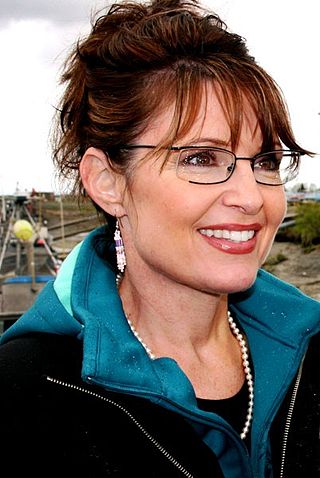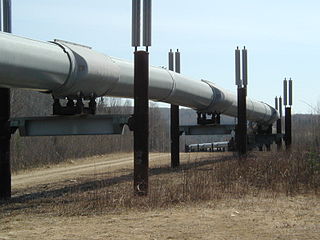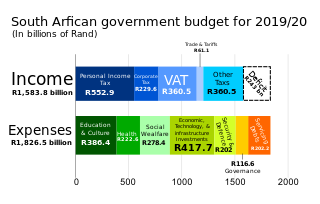
Alaska is a non-contiguous U.S. state on the northwest extremity of North America. It borders the Canadian province of British Columbia and the Yukon territory to the east; it shares a western maritime border in the Bering Strait with Russia's Chukotka Autonomous Okrug. The Chukchi and Beaufort Seas of the Arctic Ocean lie to the north and the Pacific Ocean lies to the south. Technically a semi-exclave of the U.S., it is the largest exclave in the world.

Citizen's dividend is a proposed policy based upon the Georgist principle that the natural world is the common property of all people. It is proposed that all citizens receive regular payments (dividends) from revenue raised by leasing or taxing the monopoly of valuable land and other natural resources.

The Trans-Alaska Pipeline System (TAPS) is an oil transportation system spanning Alaska, including the trans-Alaska crude-oil pipeline, 12 pump stations, several hundred miles of feeder pipelines, and the Valdez Marine Terminal. TAPS is one of the world's largest pipeline systems. The core pipeline itself, which is commonly called the Alaska pipeline, trans-Alaska pipeline, or Alyeska pipeline,, is an 800-mile (1,287 km) long, 48-inch (1.22 m) diameter pipeline that conveys oil from Prudhoe Bay, on Alaska's North Slope, south to Valdez, on the shores of Prince William Sound in southcentral Alaska. The crude oil pipeline is privately owned by the Alyeska Pipeline Service Company.

Jay Sterner Hammond was an American politician of the Republican Party, who served as the fourth governor of Alaska from 1974 to 1982. Hammond was born in Troy, New York and served as a Marine Corps fighter pilot in World War II with the Black Sheep Squadron. In 1946, he moved to Alaska where he worked as a bush pilot. Hammond served as a state representative from 1959 to 1965 and as a state senator from 1967 to 1973. From 1972 until 1974 he was the mayor of the Bristol Bay Borough. Then, in 1974, he was elected governor of Alaska.

The question of whether to drill for oil in the Arctic National Wildlife Refuge (ANWR) has been an ongoing political controversy in the United States since 1977. As of 2017, Republicans have attempted to allow drilling in ANWR almost fifty times, finally being successful with the passage of the Tax Cuts and Jobs Act of 2017.

The Alberta Heritage Savings Trust Fund(HSTF) is a sovereign wealth fund established in 1976 by the Government of Alberta under then-Premier Peter Lougheed. The Heritage Savings Trust Fund was created with three objectives: "to save for the future, to strengthen or diversify the economy, and to improve the quality of life of Albertans." The operations of the Heritage Savings Trust Fund are subject to the Alberta Heritage Savings Trust Fund Act and with the goal of providing "prudent stewardship of the savings from Alberta's non-renewable resources by providing the greatest financial returns on those savings for current and future generations of Albertans." Between 1976 and 1983 the Government of Alberta deposited a portion of oil revenue into the fund. The Heritage Savings Trust Fund used oil revenues to invest for the long term in such areas as health care, education and research and as a way of ensuring that the development of non-renewable resources would be of long-term benefit to Alberta. The strategy and goals of the fund have changed through successive provincial governments which moved away from direct investments in Alberta to a diversified approach, which now includes stocks, bonds, real estate and other ventures.

Lyman F. Hoffman is a Yup'ik politician and registered Democrat who caucuses with the Republicans in the Alaska Senate. He represents the S district since 1995, and from 1991 through 1992 previously. He was a member of the Alaska House of Representatives from 1986 through 1990, and from 1993 through 1994.
The State Income Tax Repeal, also known as Massachusetts Question 1, was one of the 2008 ballot measures that appeared on the November 4, 2008 ballot in the U.S. state of Massachusetts. Voters were asked whether or not they approved of the proposed measure which, if it had passed, would have ended the 5.3% income tax in Massachusetts on wages, interest, dividends and capital gains. Ultimately, Massachusetts voters defeated Question 1 by a wide margin, with approximately 70% opposed versus 30% in favor.

In 2006, Sarah Palin was elected governor of Alaska. Running on a clean-government platform, Palin defeated incumbent Governor Frank Murkowski in the Republican gubernatorial primary election in August. She then went on to win the general election in November, defeating former Governor Tony Knowles 48.3% to 40.9%. Her running mate was State Senator Sean Parnell.

In a report compiled by the government of Alaska, the real GDP of Alaska was $51.1 billion in 2011, $52.9 billion in 2012 and $51.5 billion in 2013. The drop-off that occurred between 2012 and 2013 has been attributed to the decline in the mining sector, specifically the oil and gas sectors, a consequence of declined production. The state's economy has been described by University of Alaska Anchorage economist Scott Goldsmith as a "three-legged stool" - with one leg being the petroleum and gas industry, the second leg being the federal government and the third leg being all other industries and services. Between 2004 and 2006, the federal government was responsible for 135,000 Alaska jobs, the petroleum sector provided 110,000 jobs and all other industries and services combined for 122,000 jobs.
The social dividend is the return on the natural resources and capital assets owned by society in a socialist economy. The concept notably appears as a key characteristic of market socialism, where it takes the form of a dividend payment to each citizen derived from the property income generated by publicly owned enterprises, representing the individual's share of the capital and natural resources owned by society.
Same-sex marriage has been legally recognized in Alaska since October 12, 2014, with an interruption from October 15 to 17 while state officials sought without success to delay the implementation of a federal court ruling. The U.S. District Court for the District of Alaska held on October 12 in the case of Hamby v. Parnell that Alaska's statutory and constitutional bans on same-sex marriage violated the Due Process and Equal Protection clauses of the U.S. Constitution. On October 15, state officials obtained a two-day stay from the Ninth Circuit Court of Appeals, which the U.S. Supreme Court refused to extend on October 17. Although Alaska is one of a few states which enforces a three-day waiting period between requesting a marriage license and conducting a marriage ceremony, at least one same-sex couple had the waiting period waived immediately after the district court's ruling. They married in Utqiagvik on October 13 and were the first same-sex couple to marry in Alaska.

Taxation may involve payments to a minimum of two different levels of government: central government through SARS or to local government. Prior to 2001 the South African tax system was "source-based", where in income is taxed in the country where it originates. Since January 2001, the tax system was changed to "residence-based" wherein taxpayers residing in South Africa are taxed on their income irrespective of its source. Non residents are only subject to domestic taxes.

William Martin Walker is an American attorney and politician who served as the 11th governor of Alaska, from 2014 to 2018. He was the second Alaska-born governor, after William A. Egan.
Alaska v. Amerada Hess et al., officially known as State v. Amerada Hess et al. (1JU-77-877) was a 15-year-long civil lawsuit levied by the state of Alaska against 17 of the world's largest oil companies for underpayment of oil production royalties. The case was named after Amerada Hess, the first company in the alphabetical list of defendants. The case cost the state more than $100 million to prosecute, and all 17 companies settled out of court rather than face trial. The total settlements amounted to just over $600 million of the $902 million the state alleged had been underpaid. Additional settlements covering underpaid natural gas royalties and refining royalties amounted to another $400 million.
In Malaysia, federal budgets are presented annually by the Government of Malaysia to identify proposed government revenues and spending and forecast economic conditions for the upcoming year, and its fiscal policy for the forward years. The federal budget includes the government's estimates of revenue and spending and may outline new policy initiatives. Federal budgets are usually released in October, before the start of the fiscal year. All of the Malaysian states also present budgets. Since state finances are dependent on money from the federal government, these budgets are usually released after the federal one.

Alaskan Bush People is an American docudrama-style reality television series that follows the Brown family in an attempt to survive in the wilderness, detached from modern society. The series premiered on the Discovery Channel on May 6, 2014. Filmed on location in Alaska near Copper Center, Hoonah, and Chichagof Island, with later seasons filmed on location in Okanogan County, Washington, it follows the extended Brown family's life. Although purportedly a genuine reality TV show, it has been criticized for being scripted and/or fake.

The 2018 Alaska gubernatorial election took place on November 6, 2018, to elect the governor and lieutenant governor of Alaska. In the primaries for recognized political parties, candidates for governor and lieutenant governor run separately. The winners of each respective primary for governor and lieutenant governor then become a joint ticket in the general election for their political party. Incumbent independent governor Bill Walker was running for re-election in what was originally a three-way race between Walker, Republican former state senator Mike Dunleavy, and Democratic nominee Mark Begich, a former U.S. Senator. However, Walker dropped out on October 19, 2018, and endorsed Begich. In spite of Walker dropping out, Dunleavy defeated Begich in what would become the only gubernatorial gain by a Republican candidate in 2018. Walker later unsuccessfully ran for Governor of Alaska in 2022.
Universal basic income and negative income tax, which is a related system, has been debated in the United States since the 1960s, and to a smaller extent also before that. During the 1960s and 1970s a number of experiments with negative income tax were conducted in United States and Canada. In the 1970s another and somewhat related welfare system was introduced instead, the Earned Income Tax Credit. The next big development in the history of basic income in the United States came in 1982, when the Alaska Permanent Fund was established. It has delivered some kind of basic income, financed from the state's oil and gas revenues, ever since.

Jack E. Hickel is an American physician and humanitarian.














